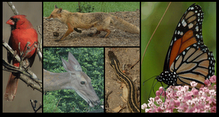Another Walk: Cardinals Always Around



Wildlife observations from a suburban backyard adjacent to the Colvin Run Mill Park in Vienna, Virginia. Click on photos to enlarge.



Posted by
Gil Miller
at
8:00 AM
0
comments
![]()
Labels: Northern Cardinal



Posted by
Gil Miller
at
5:26 PM
0
comments
![]()
Labels: Eastern Bluebird, Nests, Wren







Posted by
Gil Miller
at
8:31 PM
0
comments
![]()
Labels: Eastern Bluebird, Nests
A week ago, I took a walk in the Colvin Run Habitat (post 1, post 2, post 3, and post 4) seeking to photograph the bluebirds nesting in the bird box. A week ago, the bluebirds led me around the Habitat and proved to be elusive. Today's walk was a much different story.




Posted by
Gil Miller
at
6:26 PM
0
comments
![]()
Labels: Eastern Bluebird, Nests




Posted by
Gil Miller
at
8:15 PM
1 comments
![]()
Labels: Eastern Bluebird, Flight





Posted by
Gil Miller
at
8:12 PM
0
comments
![]()
Labels: White-throated Sparrow




Posted by
Gil Miller
at
8:08 PM
0
comments
![]()
Labels: Downy Woodpecker, Flight

This work is licensed under a Creative Commons Attribution-NonCommercial 3.0 License.
